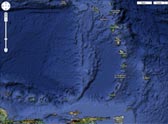Grenada

Experts puzzled by mysteries of Grenada’s unique crater lakes
Its depths are home to Orisha, the goddess of water: to followers of the old African faith, Grenada’s highest crater lake is a sanctuary. Yet beneath its dark water surface, the "Grand Etang" is still keeping a number of other secrets. Bizarre myths are woven around this natural wonder surrounded by dense mountain jungle.
By Bernhard Grdseloff
Although most of the Caribbean islands are of volcanic origin, crater lakes can only be found in Dominica and Grenada. And as if to compensate, there are three of them on the spice island: the brackish Levera Pond and Lake Antoine in the north, and the Grand Etang in the center of the island. It is in particular this 15 acre one that is full of mysteries.
"Each year, the Fire Baptists make sacrifices to the goddess Orisha on the shores of the lake", explains Wilan Hamilton, Education Officer of the Forestry. "The legend has it that the mermaid-like goddess seduces men to then drag them down into the depths of the water". Others believe that those drowning in the Grand Etang reappear in distant places: St. Vincent, Trinidad or even Venezuela.
"Nonsense ", says Hamilton, who doesn’t really know what to make of the crater lake himself, though: "We don’t actually know where the water comes from", he says. "A great deal more water flows out of the lake than comes in through the only known inlet".
Researchers have taken samples from the bottom of the lake and discovered that the pollen and spores are up to 25,000 years old...
"Each year, the Fire Baptists make sacrifices to the goddess Orisha on the shores of the lake", explains Wilan Hamilton, Education Officer of the Forestry. "The legend has it that the mermaid-like goddess seduces men to then drag them down into the depths of the water". Others believe that those drowning in the Grand Etang reappear in distant places: St. Vincent, Trinidad or even Venezuela.
"Nonsense ", says Hamilton, who doesn’t really know what to make of the crater lake himself, though: "We don’t actually know where the water comes from", he says. "A great deal more water flows out of the lake than comes in through the only known inlet".
Researchers have taken samples from the bottom of the lake and discovered that the pollen and spores are up to 25,000 years old...












